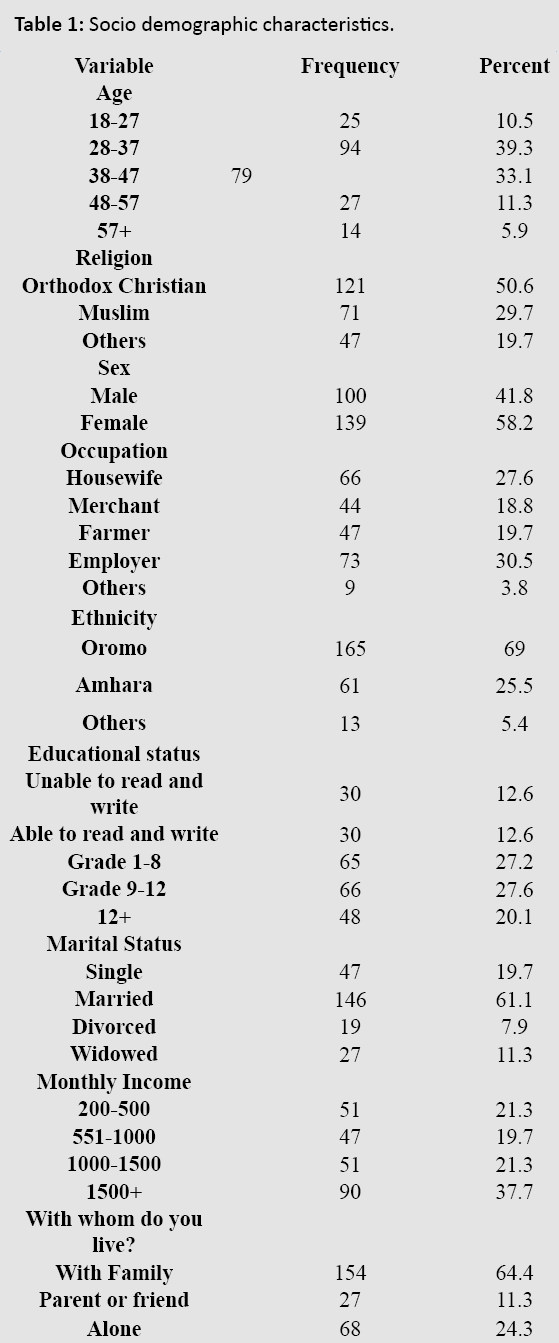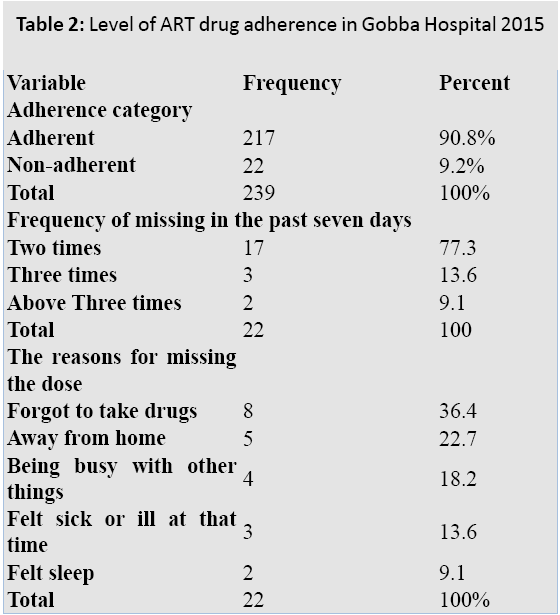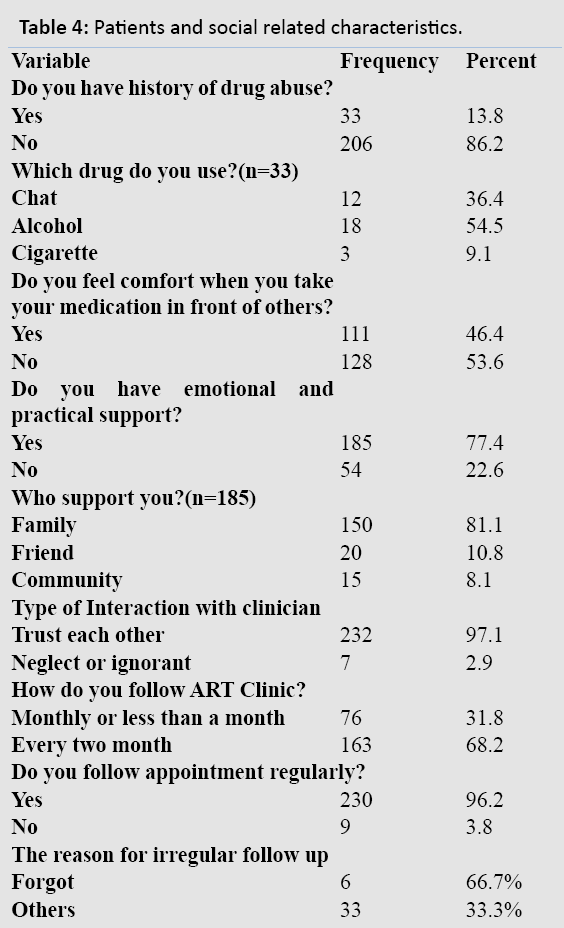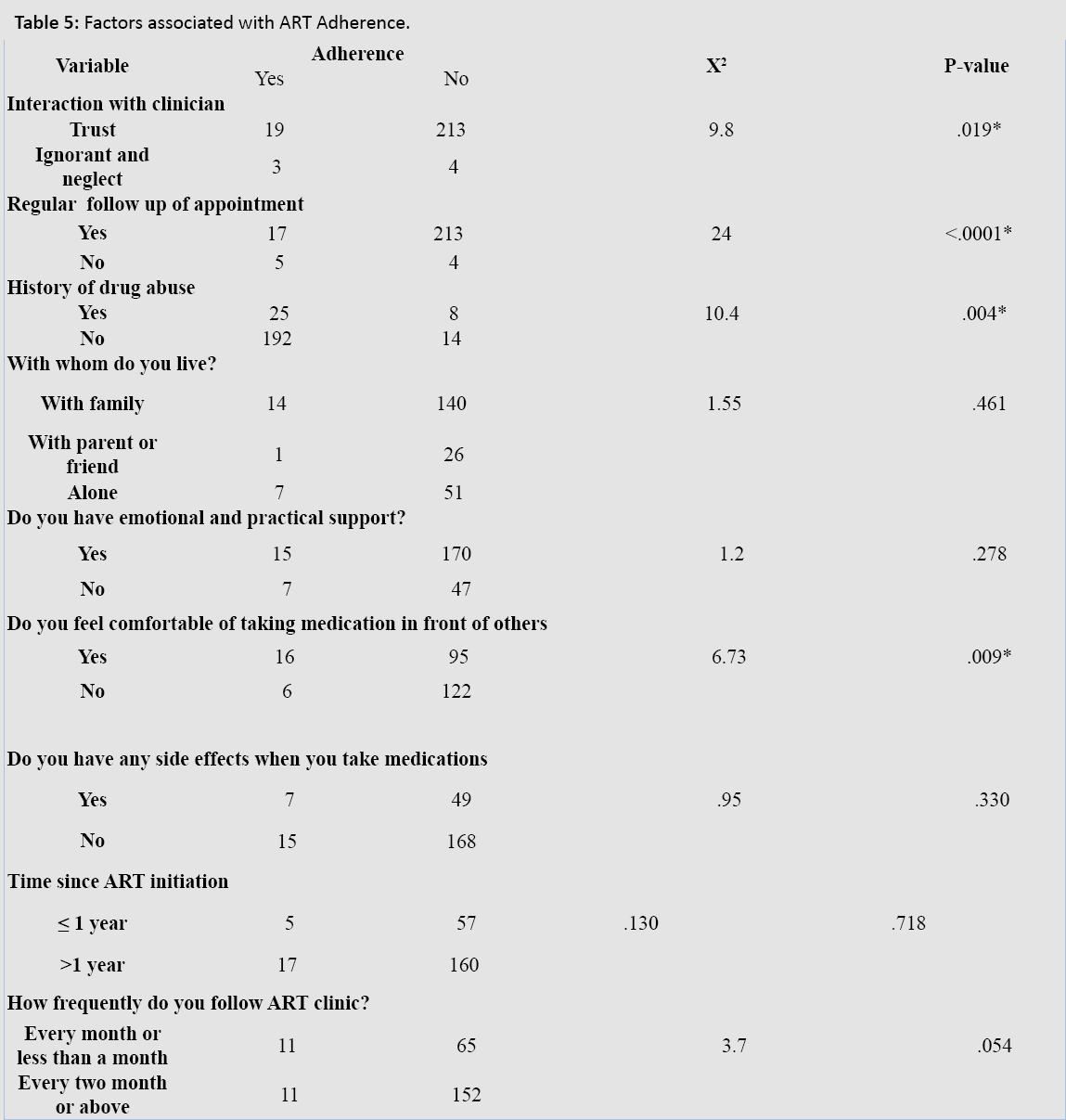Research Article - (2015) Volume 23, Issue 6
Department of Public Health, College of Medicine and Health Sciences, Madawalabu University, Bale-Robe, Ethiopia
Kadir Hasen
Boke Health Center, West Hararge Zone, Oromia Regional State, Ethiopia
Tuke Getachew
Calanqo Health Center, Oromia Regional State, Ethiopia
Mohammed Abdi
Metta Health Center, East Hararge Zone, Oromia Regional State, Ethiopia
Mareg Habtamu
Yeka health center, Addis Ababa, Ethiopia
Background: Both Human Immunodeficiency Virus (HIV) infection and Acquired Immunodeficiency Syndrome (AIDS) remain major public health problems in Ethiopia. Good adherence to anti retro viral therapy is necessary to achieve the best virological response, lower the risk that drug resistance will develop, and reduce morbidity and mortality. Little is known about the level of ART adherence in Ethiopia; particularly in Bale Zone. This study was aimed to determine the level of adherence to antiretroviral therapy and associated factors among people living with HIV/AIDS who attend ART clinic in Gobba Hospital, Bale zone of Ethiopia.
Objective: To assess the level of ART adherence and associated factors among people living with HIV-AIDS who attend ART clinic in Gobba Hospital.
Methodology: An institutional based cross- sectional study was carried out from December 2014 to June 2015 among 239 HIV positive adults in Gobba Hospital. Simple random sampling method was used to select study participants. A structured questionnaire was used for data collection. Data was analyzed by using SPSS software version 21 and the magnitude of association between the different variables in relation to the adherence to ART was assessed through chi square test and fisher exact test. The results were presented by using appropriate frequency and percentages.
Results Of the total 239 respondents, 217 (90.8%) had adherence to their ART medication. Twenty (9.2%) of them were none-adherent to take their ART drugs as prescribed. The main reasons for missing doses were forgetfulness (36.4%), and being away from home (22.7%) among others. Adherence to ART was associated with factors such as drug abuse (p= .004), interaction with clinician (p=.019), feeling comfort while taking medication in front of others (p=.009) and attending appointments regular (p=0.001)
Conclusion: The level of adherence to ART among PLWHA was relatively higher when compared with studies done in other developing country. The major reasons for missing doses were forgetfulness, away from home (travel), being busy with other things, felt sick and sleep. It is important to provide information to patients on their treatment plan to ensure patients keep their regular follow up, to improve patient’s trust with clinician
Adherence, PLWHA, ART and HIV
The Human Immunodeficiency Virus/Acquired Immunodeficiency Syndrome (HIV/AIDS) is one of the most destructive epidemics and a major threat to world population, affecting overall social, economic and political wellbeing as well as individual health.[1-3]
The majority, 97%, of them were from low and middle-income countries.2 Sub-saharan Africa remains most severely affected region with nearly 1 in every 20 adults (4.9%) living with HIV and accounting for 69% of the people living with HIV worldwide.[1] Currently, there are about 789,900 people living with HIV/AIDS in Ethiopia.[3,4] According to the 2011 Ministry of Health report, about 333,453 PLWHA were on antiretroviral treatment (ART) in Ethiopia.[5]
The benefit of adherence to ART highly depends on patients achieving and maintaining high levels of medication adherence.[6] There has been a concern about the capacity of patients in resource limited settings to adhere to ART, especially in the African context.[7] Incomplete adherence to antiretroviral agents can have serious consequences, including loss of plasma HIV suppression and leads to disease progression, inability to suppress HIV even with very intensive regimens, and development of drug resistant HIV strains. This can bring about transmission of resistant HIV to others.[8,9]
The national HIV prevalence among adults in Ethiopia has declined from 4.5% between 1998 and 1999 to 1.5% in 2011, which is an encouraging achievement for the country. However, achievement of optimal medication adherence and management of antiretroviral toxicity became great challenges among Ethiopian patients with HIV/AIDS.[10,11] There are more than 5000 peoples ever enrolled to ART at Gobba Hospital. Around 2900 of them ever started ART and 1733 are on ART as of March 2014 Hospital report.
Even though adult HIV prevalence has declined at the national level, little information is available about the adherence level of adult HIV patients in Ethiopia. Therefore, it is important to identify the factors associated with ART adherence and give an appropriate intervention timely. Thus, our study aimed to assess the magnitude of adherence to ART and identify associated factors among people living with HIV-AIDS who attend ART clinic in Gobba Hospital.
Study setting and population
The study was conducted in Gobba Hospital which is found in Gobba town, Oromia Regional State, Southeast Ethiopia from December 2014 to June 2015. In 2005 the ART Clinic of Gobba Hospital started its activity after the government launched free ART services to PLWHA. Gobba Hospital ART clinic has been giving service for 1733 of PLWHA in March 2014. All randomly selected HIV positive adults on ART follow up at Gobba Hospital, whose age greater than or equal to 18 years were included in the study. PLWHA on regular follow up at Gobba Hospital ART clinics, but who did not start ART and who are in critical medical and mental illness were excluded from the study.
Sample size and procedure
The sample size was determined using single population proportion formula by taking proportion of the level of adherence to ART at 88.6% from published study.[14] Assuming, a margin of error = 0.04, 95% Confidence interval, the sample size (n) was calculated and 10% non-response rate was added. Finally, using the correction formula, sample size was estimated to be 239.
The sampling frame was prepared based on the list of all adult ART clients who met the inclusion criteria. The respondents were chosen using simple random sampling techniques. The data was obtained following their verbal consent to participate.
Data collection procedure and tools
A structured questionnaire developed from related literatures was used for data collection.[17-19] The questionnaire contains information on socio demographic, family income, psychosocial (social support, active substance and alcohol use, use of memory aids), WHO clinical staging, drug regimen related variables (dosing schedules, side effect) and reason for nonadherence. Medical record was reviewed to identify clinical markers like CD4 count and WHO clinical staging. The interview was conducted in separated room of ART clinic. Data was collected by five health professionals who had the experience of working in the ART clinic
The questionnaire was pre-tested in Robe Hospital among 5% of the sample in order to avoid information contamination and modifications were incorporated. It was prepared in English and then translated to Afaan Oromo and Amharic (local languages of the study area); lastly retranslated back to English to ensure its consistency. The overall activity was controlled by the investigators and supervisors. All questionnaires were checked daily after data collection for completeness and consistency.
Data processing and analysis
The data was entered and analyzed by using SPSS version 21. Descriptive analysis was used to describe the distribution of respondents by socio-demographic characteristics and other relevant variables in the study. The adherence in the previous seven days was used as a dependent variable. An individual is said to be adherent if she/he missed no more than one dose (took more than 95% of prescribed dose correctly) for one week prior to interview.[14] The association of ART adherence with the independent variables was assessed by using chi-square test and fishers exact test. P-value of less than 0.05 was considered to declare statistical significance. The frequency and percentage distribution of variables was done and presented in the form of tables and figures.
Ethical consideration
Ethical clearance was taken from Ethical Review Committee of College of Medicine and Health Sciences, Madawalabu University. Permission to conduct the study was obtained from the Hospital administration. After explaining the purpose of the study a verbal consent was obtained from participants before data collection. They were informed that participating in the study is voluntary and refusal to participate would not compromise the medical care they receive from the ART clinics. The right to withdraw from the study at any time during the interview was assured. The interviews were conducted in a private room to ensure privacy. Personal identifiers were not used to ensure participants confidentiality. Data collectors were recruited from health care providers working in the ART clinic
Sociodemographic characteristics of the Participants
A total of 239 HIV infected peoples participated in the study with the response rate of 100%. The median age of the patients was 35. Majority of the participants, 121 (50.6%) were Orthodox Christians. 73(30.8%) were government employees in occupation. Concerning Ethnicity, majority of them were Oromo 165(69%) followed by Amhara 61(22.5%). Slightly more than one fourth, 66(27.6%) of the participants were educated up to grade 9-12. Slightly less than two third 146 (61.1%) of the participants were married. Ninety (37.7%) of the participants earn monthly income of >1500 ETB (Table 1). 1$ = 21 ETB

Level of ART drug adherence
Two hundred seventeen (90.8%) were adherent to the prescribed dose of ART drugs over the past seven days prior to the interview (Table 2). Twenty two (9.2%) of the participants missed the dose. The main reasons for missing doses were forgot to take drugs 8(36.4%), away from home 5(22.7%) and being busy with other things 4(18.2%) (Figure 1).

Drug regimen characteristics
Majority of the respondents 177 (74.1%) took their ART drugs for more than one year. Slightly less than one fourth 56 (23.4%) of the respondents faced drug side effect. The most common side effect was 19(33.3%) headache followed by nausea and vomiting with equal magnitude of 9(16.1%)(Table 3).

Disease related characteristics
More than half of the patients 123(51.1%) had base line CD4 count range between 200 - 500. Currently 118(49.4%) of the patients had CD4 count greater than 500. The initial WHO stage was stage three for majority of the patients 98(41%). Currently, more than three fourth 187 (78.2%) of the respondents are in stage 1.
Patient and Social related characteristics
Of the total participants, 33(13.8%) respondents had history of drug abuse. Most of them uses alcohol 18 (54.5%) followed by chat 12 (36.4%). Of those who had history of drug abuse 8 (24.2%) missed their ART drugs within the past seven days prior to the interview.
Regarding memory aids most of respondents have used watch bell 181 (75.7%) followed by pill boxes 49 (20.5%). More than three fourth of the respondents have emotional and practical support 185 (77.4%) and most of them 150 (81.1%) were supported by their family. Almost all of the patients 232 (97.1%) had trust relationship with their clinician (Table 4).

Factors associated with ART adherence
Pearson Chi-squared test and Fisher exact test were used to compare characteristics of PLWHA who were adhered to ART with those who were not. The socio demographic variables such as age, religion, sex, occupation, ethnicity, educational status, marital status and monthly income were not significantly associated with ART adherence.
The characteristics of the people living with HIV AIDs that were significantly associated with ART adherence were regular follow up of clinical appointments (P value <0.01), history of drug abuse (P value < 0.01) , feeling comfort while taking medication in front of others (P value < 0.01) and patient clinician relationship (P value =0.019). PLWHA were more likely to adhere to ART if they follow clinical appointments regularly, had no history of drug abuse, feel comfortable of taking medication in front of others and had trust relationship with their clinician (Table 5).

This study assessed the level of ART adherence and its associated factors among adult PLWHA who were on anti retro viral therapy in Gobba Hospital. ART adherence was assessed by patients self-report within the past seven days prior to interview. Based on this, 217 (90.8%) individuals had adherence to their ART drugs. This finding is higher than couple of studies done in Addis Ababa in which adherence to ART medication was 81.2% and 82.8 % respectively. [12,13] The reason for this difference could be that the studies in Addis Ababa involve many Hospitals while our study involves only one Hospital. The level of adherence in our study was comparable with those findings reported in Debre Markos and Wolaita Soddo referral Hospitals where the level of adherence was 88.6% and 87.4% respectively.[14,15]
The present study found that forgetfulness was the most frequently claimed reason for missing doses, which is similar with study findings reported in Nairobi, Kenya in which the main (38%) reason for missing therapy were being busy and forgetting.[16] Similarly, other studies in Ethiopia reported that forgetting was the main reason for missing doses in addition to other reasons like being busy and away from the home.[17,18]
Factors that might be associated with adherence to ART were assessed by Ch-square test and Fisher exact test. The socio demographic variables such as age, religion, sex, occupation, ethnicity, educational status, marital status and monthly income were not significantly associated with the level of ART adherence. This result was in agreement with other studies done in Ethiopia in which socio demographic variables remained insignificant.[12-14] There was a significant difference between patients who abuse drugs and those who don’t in terms of ART adherence. This finding is consistent with the study done in Walaita soddo referral Hospital and Nekemte Hospital in which participants who abuse drugs were non-adherent when compared to those participants who do not abuse the drugs.[15,17] There is a difference among respondents who feel comfortable to take their ART medication in front of others compared to those who do not. This finding is comparable with report of study done in Addis Ababa.[13] The level of adherence was different among respondents who follow clinical appointments regularly and those who don’t follow regularly which was consistent with the finding of study done in Uganda.[19] Similarly, the study done in Nekemte hospital has shown statistically significant difference among the participants who kept clinical appointment and who missed the clinical appointment.[17] Respondents who had trust relationship with clinician had adherence to ART drugs when compared with those neglect or ignore their clinician. This finding is comparable with study done in Debre Markos referral Hospital.1 Similarly, the study in Nekemte hospital found that relationship with health professionals is one of the factor significantly associated with drug adherence.[17]
Secondary data was reviewed to identify the clinical markers in addition to primary data
7 day recall was used to minimize recall bias
Patient self – report was used and it is subject to recall bias and omight overestimated' adherence level. Because of cross-sectional nature of the study, it did not allow the cause-effect relationships between various factors and adherence to be addressed. Despite the limitation, this finding is useful for program managers to develop appropriate strategies to address the issue of adherence from both the clinician and the patient side.
The level of adherence to ART was relatively higher when compared to others studies done in developing countries. It was in agreement with optimal adherence level (≥ 95%). The major reasons for missing doses were simple forgetfulness, away from home (travel) and being busy with other things. The level of adherence was significantly associated with variables like history of drug abuse feeling comfort of taking medication in front of others relationship with clinician and regular clinical follow up.
Health care providers should provide accessible information to patients on their treatment plan to ensure patients keep their regular follow up, improve their patient’s confidence and to avoid drug abuse. The clinicians need to improve relationship with their patients and counsel their patients on the regular follow up of the appointments and avoiding drug abuse. Finally, further study should be done with inclusion of different adherence measures and advanced statistical tests using large sample size
The author(s) declare that they have no competing interests.
KH, TG, BL, MA and MH designed the study. BL advised throughout the proposal write up, analyzed the data and prepared the manuscript. All the authors read and approved the manuscript